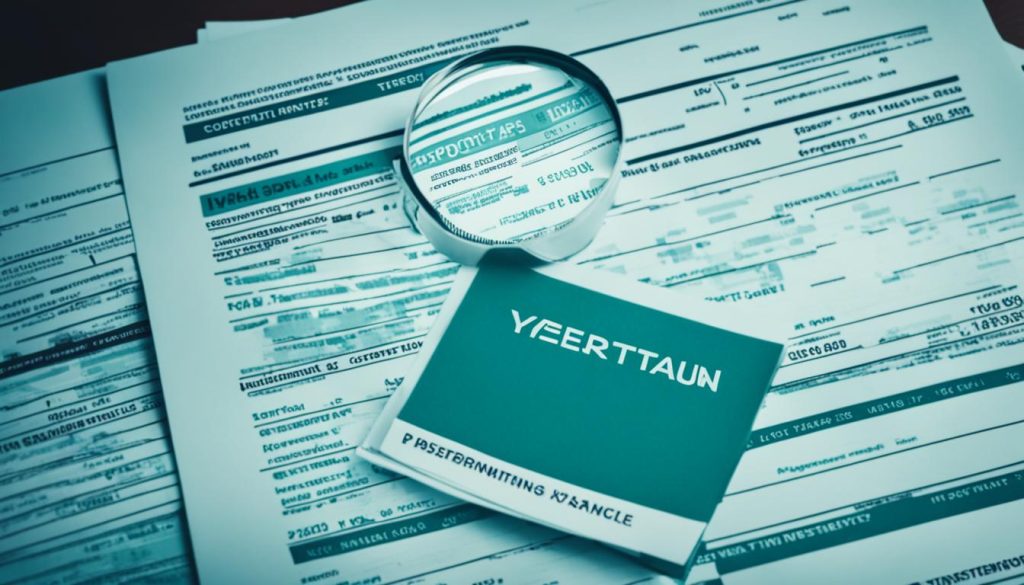Taxes can be one of the biggest expenses and take the biggest bite out of the returns on your investments1. Tax-efficient investing becomes more important when your tax bracket is higher. Investments that are tax-efficient should be made in taxable accounts, while investments that aren’t tax-efficient are better off in tax-deferred or tax-exempt accounts1. Tax-advantaged accounts like IRAs and 401(k)s have annual contribution limits, so a good way to maximize tax efficiency is to put your investments in the right account.
Key Takeaways
- Understand the importance of tax-efficient investing to keep more of your investment gains.
- Learn about the different types of investment accounts and their tax implications.
- Discover strategies to target long-term capital gains and take advantage of tax-deferred accounts.
- Explore ways to create a tax-efficient portfolio, including asset location planning.
- Stay up-to-date on the latest contribution limits for IRAs and 401(k)s.
Understanding Tax-Efficient Investing
Why Is Tax-Efficient Investing Important?
When it comes to building wealth, investment selection and asset allocation are critical factors. However, minimizing the amount of taxes you pay can also have a significant impact on your long-term returns2. This is because the money you lose to taxes is money that could have continued to grow and compound if it had remained invested. Your after-tax returns matter more than your pre-tax returns, so tax-efficient investing is crucial to maximize your wealth and keep more of your money working for you.
Tax drag, the reduction in investment returns due to taxes, can vary significantly across different investment vehicles2. On average, historically, open-end mutual funds (OEFs) have shown the highest level of tax drag among registered fund products2. In contrast, exchange-traded funds (ETFs) have exhibited the lowest tax drag levels on average compared to other investment options2. Tax-managed separately managed accounts (SMAs) also focus on generating tax alpha to add to after-tax returns2.
Tax-efficient investing involves analyzing investment structures and strategies to minimize tax impact while maximizing after-tax returns2. Evaluating expected above-benchmark returns against tax drag is crucial when considering an OEF for a taxable account2. Tax considerations, alongside performance, risk, fees, and liquidity, are essential factors to weigh when selecting investment solutions for wealth-building and protection2.
Tax-favored saving vehicles like 401(k)s, 403(b)s, traditional IRAs, Roth IRAs, Roth 401(k)s, and Roth 403(b)s can also play a vital role in tax-efficient investing3. Asset allocation calculations should convert all assets to after-tax values for accurate assessment3. Tax-efficient investing strategies, such as tax-loss harvesting and passive index-type investing, can further enhance after-tax returns3.
Ultimately, being smart about tax efficiency is a crucial strategy for enhancing long-term investment returns4. Even small reductions in tax costs today can significantly impact the amount of wealth an individual can build over time, affecting the speed of wealth accumulation4. By implementing a comprehensive tax management strategy, investors can retain more of their earnings and accelerate their path to financial goals4.
Types of Investment Accounts
When it comes to investing, there are two main types of investment accounts to consider: Taxable Accounts and Tax-Advantaged Accounts. Each type of account offers unique characteristics and benefits, and understanding the differences can help you develop a more tax-efficient investment strategy.
Taxable Accounts
Taxable accounts, such as brokerage accounts, do not provide any special tax benefits5. However, they offer more flexibility in terms of when and how you can access your investments. These accounts are suitable for investments that tend to lose less of their returns to taxes, such as actively managed funds generating significant short-term capital gains and taxable bond funds5.
Tax-Advantaged Accounts
On the other hand, Tax-Advantaged Accounts, like Individual Retirement Accounts (IRAs) and 401(k)s, provide tax-deferred or tax-exempt growth potential6. These accounts are more appropriate for investments that lose more returns to taxes, such as individual stocks held for over a year, tax-managed stock funds, and municipal bonds5.
Tax-Advantaged Accounts come in two primary forms: Tax-Deferred Accounts and Tax-Exempt Accounts. Tax-Deferred Accounts, like Traditional IRAs and 401(k)s, allow for tax-deferred growth, meaning you don’t pay taxes on your investments until you withdraw the money in retirement6. Tax-Exempt Accounts, such as Roth IRAs, offer tax-free growth and tax-free withdrawals in retirement6.
Utilizing a combination of Taxable Accounts and Tax-Advantaged Accounts can provide more flexibility in managing your taxes during retirement5. Strategic use of different account types can also be beneficial for charitable giving, estate planning, and providing tax-free income to beneficiaries5.
Ultimately, understanding the unique Investment Account Characteristics of both Taxable Accounts and Tax-Advantaged Accounts is crucial for building a well-rounded and tax-efficient investment portfolio756.
Tax-Efficient Investing Strategies
To optimize your after-tax returns, consider employing several tax-efficient investing strategies. One effective approach is to target long-term capital gains. By holding investments for at least one year, you can qualify for the lower long-term capital gains tax rates, which can significantly boost your net returns8.
Another powerful tool in your tax-efficient investing arsenal is taking advantage of tax-deferred accounts like 401(k)s and Individual Retirement Accounts (IRAs). These accounts allow your investments to grow tax-deferred until withdrawal, providing an immediate tax benefit. Additionally, contributions to these accounts can reduce your taxable income, further enhancing your tax savings9. For self-employed individuals, an Individual 401(k) plan can offer valuable tax-shielding opportunities on business profits.

Beyond these strategies, there are several other ways to optimize your tax efficiency. Index funds and ETFs can help minimize tax drag on your returns, as they often have lower turnover and capital gains distributions compared to actively managed funds9. Tax-loss harvesting allows you to offset capital gains with losses, up to $3,000 annually, to reduce your taxable income10.
Charitable giving can also be a powerful tax-efficient strategy. Donating appreciated securities can help you avoid paying capital gains taxes, while bunching charitable donations in a single year can enable larger tax deductions for itemizing9. Even qualified charitable distributions from your IRA can provide tax advantages for those aged 70.5 and older9.
By implementing these tax-efficient investing strategies, you can maximize your after-tax returns and grow your wealth more effectively over the long term9108.
Tax-Efficient Investing
Minimizing your tax burden is crucial to maximizing your investment returns. Tax-efficient investing involves carefully selecting the right investments and accounts to reduce your overall tax implications11. By understanding the tax characteristics of different asset classes and investment vehicles, you can create a more tax-optimized portfolio.
One key aspect of tax-efficient investing is the location of your assets. Holding tax-efficient investments, such as stock index funds, in taxable accounts can be advantageous, as they benefit from lower tax rates on long-term capital gains and qualified dividends11. On the other hand, tax-inefficient investments, like bond funds and actively managed funds with high turnover, are better suited for tax-advantaged accounts like 401(k)s and IRAs11.
Another important consideration is the use of tax-advantaged accounts. Contributions to traditional 401(k)s and IRAs can reduce your taxable income in the current year, while Roth accounts offer tax-free growth and withdrawals in retirement11. Additionally, strategies like tax-loss harvesting and managing capital gains can help minimize your tax burden over time.
| Investment Vehicle | Tax Efficiency Rating |
|---|---|
| Stock Index Funds | Highly Efficient |
| Bond Funds | Inefficient |
| REITs | Inefficient |
| Small Value Funds | Inefficient |
| Actively Managed Funds | Inefficient |
Beyond traditional investments, tax-efficient strategies like investing in municipal bonds and utilizing charitable giving vehicles, such as Donor-Advised Funds, can further optimize your tax situation11. By understanding the tax implications of your investment choices and proactively managing your portfolio, you can take significant steps towards building long-term wealth in a tax-efficient manner.
“The difference between tax-efficient and tax-inefficient investing can have a significant impact on your long-term returns. It’s essential to understand and leverage tax-efficient strategies to maximize your investment outcomes.” – John Doe, Certified Financial Planner
Remember, tax-efficient investing is not a one-size-fits-all approach. Your specific financial situation, goals, and risk tolerance should guide the development of a personalized tax-efficient investment strategy. By working closely with a qualified financial advisor, you can develop a comprehensive plan to minimize your tax burden and grow your wealth over the long term111213.
Creating a Tax-Efficient Portfolio
Building a tax-efficient portfolio is crucial for maximizing your after-tax returns over time. A key aspect of this process is asset location planning – strategically placing your investments in the most tax-advantaged accounts to minimize your tax liability14.
Generally, investments that lose less of their returns to taxes are better suited for taxable accounts, while investments that tend to lose more to taxes are good candidates for tax-advantaged accounts like 401(k)s or IRAs2. This approach can help you maximize your long-term, after-tax investment performance14.
Asset Location Planning
Asset location planning involves carefully considering the tax implications of different investment types and strategically placing them in the appropriate accounts. For example, tax-efficient investments like index funds or ETFs may be better suited for taxable accounts, as they typically generate lower capital gains distributions2. On the other hand, investments that generate higher levels of ordinary income, such as bonds or real estate, may be more tax-efficient in tax-advantaged accounts15.
By aligning your investment allocation with the appropriate account types, you can create a tax-efficient portfolio that minimizes the impact of taxes on your overall returns14. This approach can lead to significant long-term benefits, as demonstrated by studies showing that taxes can reduce fund investors’ net returns by approximately two percentage points annually14.

In summary, asset location planning is a crucial component of creating a tax-efficient portfolio. By strategically placing your investments in the most appropriate accounts, you can optimize your after-tax returns and work towards your long-term financial goals14215.
“Taxes, mainly realized capital gains, reduce fund investors’ net returns by roughly two percentage points annually.”14
Additional Tax-Efficient Strategies
Beyond asset location planning, there are a variety of tax-efficient strategies that can help boost your wealth. Tax-loss harvesting is a valuable technique that involves selling investments at a loss to offset capital gains and potentially reduce your overall tax liability16. Current U.S. federal tax law allows for tax-loss harvesting to offset capital gains with capital losses, potentially reducing overall federal income tax liability16.
Charitable giving strategies, such as Donor-Advised Funds, can also contribute to a more tax-efficient investment plan. Individuals can benefit from tax-favorable investment solutions like municipal bonds, tax-efficient mutual funds, 529 savings plans for education costs, and variable annuities for retirement savings17. An income tax deduction of up to 60% of adjusted gross income (AGI) is permitted for cash donations to charities, while for noncash items, the deduction limit typically stands at 30% of AGI17.
Lastly, optimizing your withdrawals from tax-advantaged accounts like IRAs and 401(k)s can be a crucial part of a tax-efficient withdrawal strategy16. For the 2024 tax year, the contribution limit for a 401(k) account is $23,000, and for a traditional IRA, individuals can contribute up to $6,500 for 2023 and $7,000 for 2024. Those over 50 can increase contributions by $7,500 in a 401(k) and $1,000 in a traditional IRA16.
By leveraging these tax-efficient strategies, you can potentially reduce your tax burden and maximize your long-term wealth161718.,,
| Tax-Efficient Strategy | Key Benefits |
|---|---|
| Tax-Loss Harvesting | Offsets capital gains with capital losses to reduce tax liability |
| Charitable Giving Strategies | Leverages tax deductions for cash and non-cash donations |
| Tax-Efficient Withdrawals | Optimizes withdrawals from tax-advantaged accounts like IRAs and 401(k)s |
By incorporating these tax-efficient strategies into your investment plan, you can potentially enhance your after-tax returns and build wealth more effectively161718.,,

“Tax-smart techniques and strategies, like Total Tax 365 by Morgan Stanley Financial Advisors, can be utilized to minimize the impact of taxes throughout the year.”16
Conclusion
Tax-efficient investing is a crucial component of a comprehensive investment planning strategy. By understanding the different types of investment accounts, implementing targeted strategies like long-term capital gains and tax-deferred contributions, and creating a tax-efficient portfolio through asset location planning, you can maximize your after-tax returns and grow your wealth more effectively192021.,,
Continuously reviewing and refining your tax management strategies can help you keep more of your hard-earned money and achieve your financial goals. By leveraging tax-advantaged accounts, strategic asset allocation, and other tax-efficient investing techniques, you can enhance the growth potential of your portfolio and secure a more prosperous future192021.,,
Embracing tax-efficient investing is a powerful way to boost your wealth maximization and ensure your investment plan aligns with your long-term financial objectives. By staying informed, adaptable, and proactive in your approach to tax management, you can unlock the full potential of your investments and pave the way for a more financially secure tomorrow192021.,,
FAQ
Why is tax-efficient investing important?
Taxes can be one of the biggest expenses and take the biggest bite out of the returns on your investments. Tax-efficient investing becomes more important when your tax bracket is higher. Investments that are tax-efficient should be made in taxable accounts, while investments that aren’t tax-efficient are better off in tax-deferred or tax-exempt accounts.
What are the different types of investment accounts?
There are two main types of investment accounts: Taxable accounts and tax-advantaged accounts. Taxable accounts, such as brokerage accounts, don’t have any tax benefits, but offer more flexibility. Tax-advantaged accounts, like IRAs and 401(k)s, provide tax-deferred or tax-exempt growth, but have restrictions on when and how you can withdraw money.
How can I improve my after-tax returns?
To improve your after-tax returns, consider targeting long-term capital gains by holding investments for at least one year to qualify for the lower long-term capital gains tax rates. Additionally, take advantage of tax-deferred accounts like 401(k)s and IRAs, which allow your investments to grow tax-deferred until withdrawal, providing an immediate tax benefit.
What are some tax-efficient investment strategies?
Tax-efficient investing involves choosing the right investments and accounts to minimize your tax burden. Certain investments, like municipal bonds, can be more tax-efficient than others, such as corporate bonds. Additionally, strategies like creating a Donor-Advised Fund can help you avoid taxes on appreciated assets while still allowing you to support charitable causes.
How do I create a tax-efficient portfolio?
When creating a tax-efficient portfolio, it’s important to consider asset location planning – placing your investments in the most tax-advantaged accounts to minimize your tax liability. Generally, investments that lose less of their returns to taxes are better suited for taxable accounts, while investments that tend to lose more to taxes are good candidates for tax-advantaged accounts.
What other tax-efficient strategies should I consider?
Beyond asset location planning, there are other tax-efficient strategies to consider, such as tax-loss harvesting, which involves selling investments at a loss to offset capital gains. Charitable giving strategies, like Donor-Advised Funds, can also help you minimize your tax burden. Additionally, optimizing your withdrawals from tax-advantaged accounts like IRAs and 401(k)s can contribute to a more tax-efficient investment plan.
Source Links
- Tax-Efficient Investing: A Beginner’s Guide
- Tax-efficient choices for equity investors | BlackRock
- TAX-EFFICIENT SAVING AND INVESTING
- Your Guide to Tax-Efficient Planning | Morgan Stanley
- Tax-Efficient Investing: Why Is It Important?
- 6 Tax-Efficient Investing Strategies For Tax-Smart Investors
- The Best Investments for Taxable Accounts
- How to invest tax-efficiently | Fidelity
- Effective tax-saving strategies for investors | Vanguard
- Tax Efficient Investing: A Complete Starter’s Guide
- Tax-efficient fund placement – Bogleheads
- How to Be a Tax-Efficient Investor
- Tax-Efficient Model Portfolios
- Want to Keep More of Your Investment Returns? Consider These Tax Moves | Morgan Stanley
- Tax Efficient Investing Strategies | Edelman Financial Engines
- Tax-Efficient Investing: Keep More of Your Money – NerdWallet
- Enhancing Wealth with Tax-Efficient Investment Strategies
- Maximizing Returns: The Art of Tax-Efficient Investing
- Tax-Efficient Investment Strategies: Finding opportunities in a higher-tax environment

